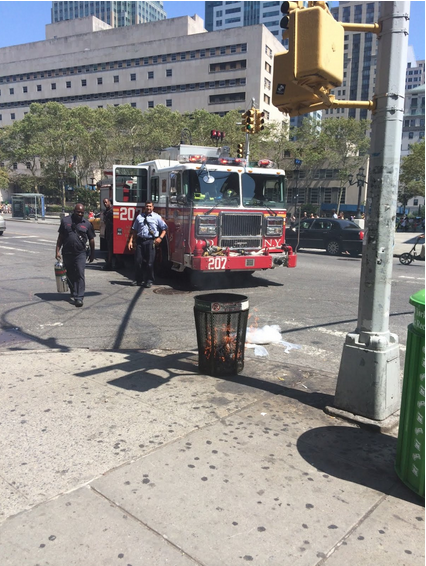Fire safety on the mean streets of Brooklyn! #HazardSpotting
#HazardSpotting is a community safety initiative that helps raise awareness about dangerous workplace safety violations. Our audience submits pictures, and we write an article with insight from featured safety professionals.
Hazards come in all forms, shapes, and sizes. We’ve discussed several safety shortcomings involving fall protection and prevention, personal protective equipment, and slips, trips, and falls. However, we have yet to directly cover fire safety — until now.

Click on the image to see it full screen, or roll your mouse over the image to zoom in for more details!
A few weeks ago, one of our colleagues happened upon this fiery trash can right outside the MySafetySign office in Brooklyn Heights, nestled in between the borough’s municipal headquarters, residences, and office buildings. This particular intersection has a high flux of pedestrian and vehicle traffic throughout the day. It’s considered an open fire, which is illegal by New York State law. It was a mild and breezy day, not one of those fry-the-egg-on-the-sidewalk summer days, so we can’t say for sure what caused the combustion but we’re pretty sure it was human error.
Although the flame was contained to just the garbage receptacle, unfortunately it isn’t the case each time. Urban areas face a slew of challenges that other environments do not when it comes to fires. The National Fire Protection Association says that intentional fire rates are highest in large cities, where congestion and density conditions can create powder keg scenarios. They offer a five-step planning process to ensuring fire-safe communities:
- Conduct a community fire analysis: Identify fire and life safety problems and the demographic characteristics of those at risk.
- Develop partnerships in the community: Community partners are people, groups, or organizations willing to join forces and address a risk to the community at large. The most effective risk reduction efforts involve the community in the planning and solution process.
- Create a strategy to solve the problem: An intervention strategy is the beginning of the detailed work necessary for the development of a successful fire or life safety risk reduction process.
- Implement the strategy in the community: Implementing the strategy involves testing the interventions and then putting the plan into action in the community. A well-coordinated and properly sequenced implementation is essential. Implementation occurs when the intervention strategy is put in place and the implementation plan schedules are followed.
- Evaluate the results: The primary goal of the evaluation process is to demonstrate that the risk reduction efforts are reaching target populations, have the planned impact, and are demonstrably reducing loss. The evacuation measures performance on several levels, including formative, process, impact, and outcome objectives.
The hazards posed to passerby, motorists, and nearby buildings could have been serious if the open fire wasn’t contained quickly by firefighters.
Have you encountered a similar situation? We’d like to hear your experiences from where you live.
And if you’ve got a #HazardSpotting photo to submit, send an email to krissa at smartsign dot com or talk to us on Twitter!
Related articles
Category: #HazardSpotting













